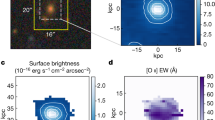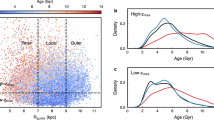Abstract
THE first detection of the 18-cm lines of the OH radical was recently reported by Weinreb, Barrett, Meeks and Henry1. The lines were observed in absorption in the spectrum of Cassiopeia A at frequencies agreeing closely with laboratory values. Optical depths of 0.016 and 0.010 were measured corresponding to values of ∼ 3 for hydrogen lines with the same radial velocities. As the optical depth of the zero-velocity hydrogen line in the galactic centre source (Sagittarius A) is also of the order of 3 and its line width is greater than those in Cassiopeia A, it appeared that we might be able to confirm the results given in ref. 1 with easily improvised equipment.
This is a preview of subscription content, access via your institution
Access options
Subscribe to this journal
Receive 51 print issues and online access
$199.00 per year
only $3.90 per issue
Buy this article
- Purchase on SpringerLink
- Instant access to full article PDF
Prices may be subject to local taxes which are calculated during checkout
Similar content being viewed by others
References
Weinreb, S., Barrett, A. H., Meeks, M. L., and Henry, J. C., Nature, 200, 829 (1963).
Clark, B. G., Radhakrishnan, V., and Wilson, R. W., Astrophys. J., 135, 151 (1962).
Author information
Authors and Affiliations
Rights and permissions
About this article
Cite this article
BOLTON, J., VAN DAMME, K., GARDNER, F. et al. Observation of OH Absorption Lines in the Radio Spectrum of the Galactic Centre. Nature 201, 279 (1964). https://doi.org/10.1038/201279a0
Issue date:
DOI: https://doi.org/10.1038/201279a0
This article is cited by
-
An Intense Concentration of Oh near the Galactic Centre
Nature (1964)
-
High-resolution Microwave Spectra of H and OH Absorption Lines of Cassiopeia A
Nature (1964)
-
OH Absorption Spectra in Sagittarius
Nature (1964)



